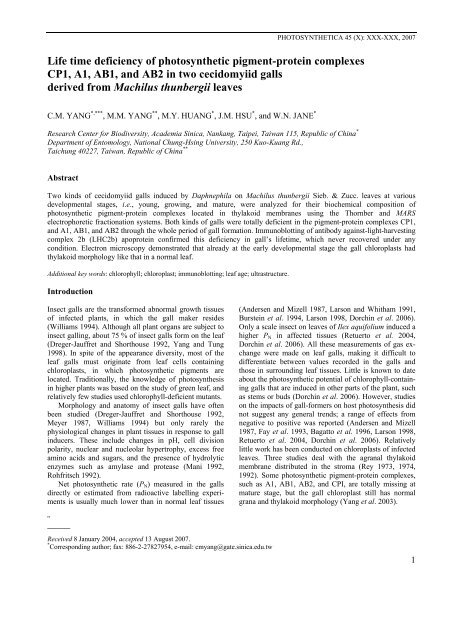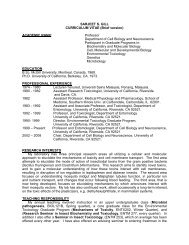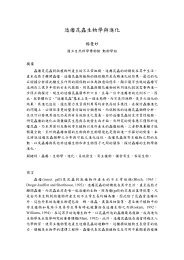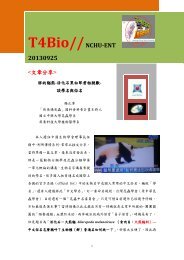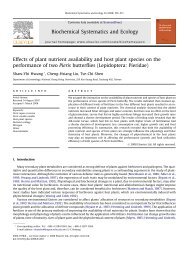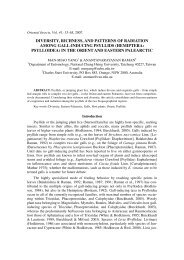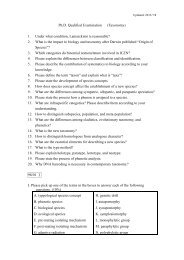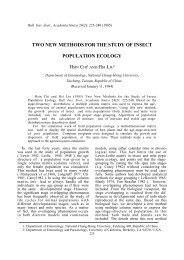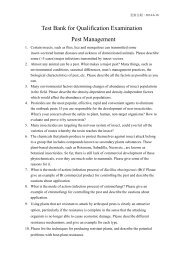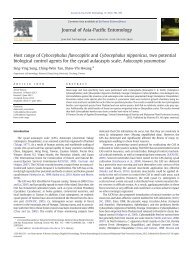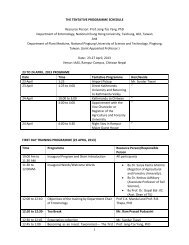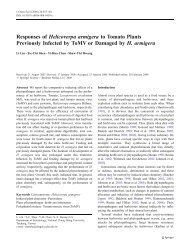Life time deficiency of photosynthetic pigment-protein complexes ...
Life time deficiency of photosynthetic pigment-protein complexes ...
Life time deficiency of photosynthetic pigment-protein complexes ...
Create successful ePaper yourself
Turn your PDF publications into a flip-book with our unique Google optimized e-Paper software.
PHOTOSYNTHETICA 45 (X): XXX-XXX, 2007<strong>Life</strong> <strong>time</strong> <strong>deficiency</strong> <strong>of</strong> <strong>photosynthetic</strong> <strong>pigment</strong>-<strong>protein</strong> <strong>complexes</strong>CP1, A1, AB1, and AB2 in two cecidomyiid gallsderived from Machilus thunbergii leavesC.M. YANG *,*** , M.M. YANG ** , M.Y. HUANG * , J.M. HSU * , and W.N. JANE *Research Center for Biodiversity, Academia Sinica, Nankang, Taipei, Taiwan 115, Republic <strong>of</strong> China *Department <strong>of</strong> Entomology, National Chung-Hsing University, 250 Kuo-Kuang Rd.,Taichung 40227, Taiwan, Republic <strong>of</strong> China **AbstractTwo kinds <strong>of</strong> cecidomyiid galls induced by Daphnephila on Machilus thunbergii Sieb. & Zucc. leaves at variousdevelopmental stages, i.e., young, growing, and mature, were analyzed for their biochemical composition <strong>of</strong><strong>photosynthetic</strong> <strong>pigment</strong>-<strong>protein</strong> <strong>complexes</strong> located in thylakoid membranes using the Thornber and MARSelectrophoretic fractionation systems. Both kinds <strong>of</strong> galls were totally deficient in the <strong>pigment</strong>-<strong>protein</strong> <strong>complexes</strong> CP1,and A1, AB1, and AB2 through the whole period <strong>of</strong> gall formation. Immunoblotting <strong>of</strong> antibody against-light-harvestingcomplex 2b (LHC2b) apo<strong>protein</strong> confirmed this <strong>deficiency</strong> in gall’s life<strong>time</strong>, which never recovered under anycondition. Electron microscopy demonstrated that already at the early developmental stage the gall chloroplasts hadthylakoid morphology like that in a normal leaf.Additional key words: chlorophyll; chloroplast; immunoblotting; leaf age; ultrastructure.IntroductionInsect galls are the transformed abnormal growth tissues<strong>of</strong> infected plants, in which the gall maker resides(Williams 1994). Although all plant organs are subject toinsect galling, about 75 % <strong>of</strong> insect galls form on the leaf(Dreger-Jauffret and Shorthouse 1992, Yang and Tung1998). In spite <strong>of</strong> the appearance diversity, most <strong>of</strong> theleaf galls must originate from leaf cells containingchloroplasts, in which <strong>photosynthetic</strong> <strong>pigment</strong>s arelocated. Traditionally, the knowledge <strong>of</strong> photosynthesisin higher plants was based on the study <strong>of</strong> green leaf, andrelatively few studies used chlorophyll-deficient mutants.Morphology and anatomy <strong>of</strong> insect galls have <strong>of</strong>tenbeen studied (Dreger-Jauffret and Shorthouse 1992,Meyer 1987, Williams 1994) but only rarely thephysiological changes in plant tissues in response to gallinducers. These include changes in pH, cell divisionpolarity, nuclear and nucleolar hypertrophy, excess freeamino acids and sugars, and the presence <strong>of</strong> hydrolyticenzymes such as amylase and protease (Mani 1992,Rohfritsch 1992).Net <strong>photosynthetic</strong> rate (P N ) measured in the gallsdirectly or estimated from radioactive labelling experimentsis usually much lower than in normal leaf tissues(Andersen and Mizell 1987, Larson and Whitham 1991,Burstein et al. 1994, Larson 1998, Dorchin et al. 2006).Only a scale insect on leaves <strong>of</strong> Ilex aquifolium induced ahigher P N in affected tissues (Retuerto et al. 2004,Dorchin et al. 2006). All these measurements <strong>of</strong> gas exchangewere made on leaf galls, making it difficult todifferentiate between values recorded in the galls andthose in surrounding leaf tissues. Little is known to dateabout the <strong>photosynthetic</strong> potential <strong>of</strong> chlorophyll-containinggalls that are induced in other parts <strong>of</strong> the plant, suchas stems or buds (Dorchin et al. 2006). However, studieson the impacts <strong>of</strong> gall-formers on host photosynthesis didnot suggest any general trends; a range <strong>of</strong> effects fromnegative to positive was reported (Andersen and Mizell1987, Fay et al. 1993, Bagatto et al. 1996, Larson 1998,Retuerto et al. 2004, Dorchin et al. 2006). Relativelylittle work has been conducted on chloroplasts <strong>of</strong> infectedleaves. Three studies deal with the agranal thylakoidmembrane distributed in the stroma (Rey 1973, 1974,1992). Some <strong>photosynthetic</strong> <strong>pigment</strong>-<strong>protein</strong> <strong>complexes</strong>,such as A1, AB1, AB2, and CPI, are totally missing atmature stage, but the gall chloroplast still has normalgrana and thylakoid morphology (Yang et al. 2003).¨———Received 8 January 2004, accepted 13 August 2007.* Corresponding author; fax: 886-2-27827954, e-mail: cmyang@gate.sinica.edu.tw1
C.M. YANG et al.The above data were obtained by analyzing the gallscollected from their mature stage. A further questionarose on whether the <strong>pigment</strong>-<strong>protein</strong> <strong>complexes</strong> weredeficient at the beginning <strong>of</strong> gall formation. Therefore weanalyzed the biochemical composition <strong>of</strong> <strong>pigment</strong>-<strong>protein</strong><strong>complexes</strong> <strong>of</strong> thylakoid membrane isolated from young(Y), growing (G), and mature (M) cecidomyiid gallchloroplasts <strong>of</strong> M. thunbergii Sieb. & Zucc. leaves,respectively. The same unique pattern <strong>of</strong> <strong>pigment</strong>-<strong>protein</strong>complex, which is different from that in normalchloroplast, was discovered in all stages <strong>of</strong> gall.Materials and methodsPlant and gall: The green obovate and red oval-pointedgalls induced by Daphnephila spp. (Diptera,Cecidomyiidae), with various sizes at three variousdevelopmental stages and residing on the lower epidermis<strong>of</strong> Machilus thunbergii Sieb. & Zucc. (Lauraceae) leaveswere collected from Chung-Cheng Mountain <strong>of</strong> theYangmingshan National Park in northern Taiwan duringdifferent seasons (Fig. 1). The two galls take about sixmonths to develop and grow from deposition to maturity.Y, G, and M galls were collected in October andDecember <strong>of</strong> 2002 and March <strong>of</strong> 2003, respectively. Thegalls were detached from the infected mature leaves, andthe surrounding healthy leaf tissue was trimmed to avoidcontamination. All experiments were conducted on bothgalls, and all results were the same, so only the data <strong>of</strong>the green obovate gall is presented in this article. Thesame results were also found in the gall growth seasons<strong>of</strong> 2001–2002 and 2003–2004.Pigment-<strong>protein</strong> <strong>complexes</strong>: Thylakoid membraneswere purified from both leaf and detached galls bydifferential centrifugation and were further analyzed fortheir constituent <strong>pigment</strong>-<strong>protein</strong> <strong>complexes</strong> by solubilizationwith SDS and electrophoresis on the gel <strong>of</strong>Thornber and MARS fractionation systems (Markwell1986). The system <strong>of</strong> Thornber resolves two <strong>pigment</strong><strong>protein</strong><strong>complexes</strong>, termed CP1 and CP2, in addition to azone <strong>of</strong> free <strong>pigment</strong> (FP). The MARS system resolvesfour <strong>pigment</strong>-<strong>protein</strong> <strong>complexes</strong>, named A1, AB1, AB2,and AB3, besides the free <strong>pigment</strong> zone (Markwell1986).Detection <strong>of</strong> LHC2 apo<strong>protein</strong>s: The fractionated<strong>pigment</strong>-<strong>protein</strong> <strong>complexes</strong> in the Thornber and MARSgels (Markwell 1986) were directly trans-blotted onto thenitrocellulose paper. Non-fat dry milk was used as ablocking agent. The immunoblots were incubated withantibodies against LHC2a, LHC2b, and LHC2c apo<strong>protein</strong>s<strong>of</strong> Ficus microcarpa leaf, and visualized bymeans <strong>of</strong> a goat anti-mouse IgG conjugated with alkalinephosphatase and the NBT-BCIP (nitro blue tetrazoliumchloride-5-bromo-4-chloro-3-indolyl phosphate) chromogenicdetection system as described by Leary et al.(1983). Only the data <strong>of</strong> the LHC2b immunoblot arepresented here because data <strong>of</strong> all three LHC21apo<strong>protein</strong>s are the same.Transmission electron microscopy: The material wasprepared according to the method <strong>of</strong> Spurr (1969). Theinner part <strong>of</strong> gall at various developmental stages andcentral part <strong>of</strong> leaf were collected and cut into smallcubes into the size <strong>of</strong> 1 mm 3 pieces, which was then putinto a buffer solution containing 0.1 M phosphate buffer(pH 7.3) and 2.5 % glutaraldehyde, and underwentprefixation for 2–4 h at 4 °C. After this, washing wasdone twice using 0.1 M phosphate buffer <strong>of</strong> 5 % sucrosesolution, 15 min each <strong>time</strong>, and then using 0.1 Mphosphate buffer solution containing 1 % osmic acid topostfix for 1–2 h. Again, the sample was washed with0.1 M phosphate buffer <strong>of</strong> 5 % sucrose twice. The samplewas dehydrated with a series <strong>of</strong> ascending acetoneconcentrations, 50, 50, 70, 70, 90, 90, and 100 % 15 mineach, which was followed by resin/acetone (1/2),resin/acetone (1/1), and resin/acetone (2/1) for 1, 2, and4 h, respectively. Finally, 100 % resin was used overnightbefore being taken out, and then 100 % resin for 1–3 h.After embedding, it was placed in a 70 °C oven forpolymerization for 8–48 h. Ultracut E machine (Reichert–Jung, Australia) was applied to cut samples into 60–90 nm chips, which were salvaged with a grid coveredwith film. Double-dyeing in uranyl acetate and 0.4 % leadcitrate followed. The thylakoid morphology wasexamined with a Philips CM 100 transmission electronmicroscope at 75 kV.Results and discussionGall appearance and greenness: Two galls, greenobovate and red oval-pointed, at three developmentalstages, i.e. Y, G, and M, were approximately 1.5, 3.5, and5.5 mm in diameter, respectively (Fig. 1). The fruit-likegalls were formed on the lower epidermis <strong>of</strong> leaves. Ingreen obovate gall the inner area was as green as that <strong>of</strong>higher plant leaf. In contrast, the red oval-pointed gallwas less green and showed reddish purple inside (data notshown). During their life<strong>time</strong>, galls grew under shade.Their chlorophyll (Chl) a/b ratios were between 2.5 and2.8, i.e. in the range <strong>of</strong> normal leaf (usually around 3).Pigment-<strong>protein</strong> <strong>complexes</strong>: The system <strong>of</strong> Thornberelectrophoresis showed that the infected leaves at any2
LIFE TIME DEFICIENCY OF PHOTOSYNTHETIC PIGMENT-PROTEIN COMPLEXESstages <strong>of</strong> M. thunbergii contained both the CP1 and CP2<strong>pigment</strong>-<strong>protein</strong> <strong>complexes</strong> commonly found in higherplants while the two insect galls, at all developmentalstages, contained only CP2 (Fig. 2). CP1 is derived fromphotosystem (PS) 1 and contains mainly Chl a, whileCP2 contains both Chl a and b and is derived from PS2(Markwell 1986). The MARS electrophoretic systemresolves only AB3 <strong>of</strong> the three <strong>pigment</strong>-<strong>protein</strong><strong>complexes</strong> containing Chl a and b present in the normalthylakoid membranes <strong>of</strong> leaf at any development stage(Fig. 2). The <strong>pigment</strong>-<strong>protein</strong> complex A1 is a constituentpart <strong>of</strong> the core <strong>of</strong> PS1, and AB1, AB2, and AB3 arederived from light-harvesting complex 2 (LHC2). Thetwo cecidomyiid galls at any <strong>of</strong> the developmental stages<strong>of</strong> M. thunbergii are totally deficient in the <strong>pigment</strong><strong>protein</strong><strong>complexes</strong> CPI, A1, AB1, and AB2, and no<strong>deficiency</strong> was recovered at any <strong>time</strong> or under anycondition.Fig. 1. The obovate cecidomyiid galls caused by Daphnephila sp. at various developmental stages on the leaf <strong>of</strong> M. thunbergii. A, B,and C are young (Y), growing (G), and mature (M) galls, respectively. D is an inside pr<strong>of</strong>ile <strong>of</strong> mature gall. A yellow larva resides inthe lower space <strong>of</strong> the left half gall chamber.Fig. 2. Pigment-<strong>protein</strong> <strong>complexes</strong> <strong>of</strong> thylakoidmembranes isolated from the obovate cecidomyiidgalls induced by Daphnephila sp. at variousdevelopmental stages on the leaf <strong>of</strong> M. thunbergii.An oligomeric form (O) <strong>of</strong> the CP2 complex isvisible migrating between CPI and CPII. L, leaf; Y,young gall; G, growing gall; M, mature gall.LHC2 apo<strong>protein</strong>s: To estimate their content in the<strong>pigment</strong>-<strong>protein</strong> <strong>complexes</strong> <strong>of</strong> the two gall chloroplasts,three antibodies against LHC2a, LHC2b, and LHC2c <strong>of</strong>F. microcarpa were used. The pattern <strong>of</strong> <strong>pigment</strong>-<strong>protein</strong><strong>complexes</strong> was further confirmed by western blotting <strong>of</strong>antibody against LHC2b apo<strong>protein</strong> (Fig. 3). Only CP2and its oligomeric form (O), and AB1, AB2, and AB3contained the three LHC2 apo<strong>protein</strong>s. The two galls atall developmental stages contained only CP2 and AB3, inwhich LHC2b apo<strong>protein</strong> resides.The <strong>pigment</strong>-<strong>protein</strong> complex pattern <strong>of</strong> the insectgall is the same as that <strong>of</strong> mungbean testa (Yang et al.1995) and black bean testa (Lu 2000) at alldevelopmental stages, and neither <strong>of</strong> them is found in thenormal chloroplast. The <strong>deficiency</strong> <strong>of</strong> <strong>pigment</strong>-<strong>protein</strong><strong>complexes</strong> in insect-induced gall derived from infectedleaf and in the green tissue <strong>of</strong> mungbean and black beanseed-coats is an interesting coincidence. The <strong>protein</strong>content <strong>of</strong> the inner gall tissue and that <strong>of</strong> non-gall planttissues surrounding cynipid galls is very different(Schörogge et al. 2000). The former might involve theectopic expression <strong>of</strong> seed-specific <strong>protein</strong>s. However,these <strong>protein</strong>s are not derived from leaves.Fig. 3. Immunoblotting <strong>of</strong> antibody against LHC2bapo<strong>protein</strong> in the fractionated <strong>pigment</strong>-<strong>protein</strong><strong>complexes</strong> isolated from various developmentalgalls analyzed by Thornber and MARSelectrophoretic systems. L, leaf; Y, young gall; G,growing; M, mature gall.Thylakoid morphology: Ultrastructural study showedthat the chloroplast <strong>of</strong> gall at all stages on the leaf <strong>of</strong> M.thunbergii had normal grana and thylakoid morphologyand is the same as that <strong>of</strong> other higher plant leaves(Fig. 4). Our results reconfirmed the previous report(Yang et al. 2003) and even the gall chloroplast thylakoidat very early developmental stage still expresses normalmorphology. The number <strong>of</strong> paired thylakoid membranesper granum in gall chloroplast increases as gall grows.According to Rey (1973, 1974) the chloroplasts in thegall <strong>of</strong> Pontania proxima Lep-infected willow leaf nevercontain starch, but a bundle <strong>of</strong> tubules appears in their3
C.M. YANG et al.stroma which is very <strong>of</strong>ten isolated in a stretched lobe.We observed similar thylakoid morphology, but at thevery early stages <strong>of</strong> gall growth and development and notat the studied stages (data not shown). The results alsoshow that besides the LHC2 complex, other factors mayget involved in grana formation.Fig. 4. Ultrastructural morphology <strong>of</strong> chloroplastthylakoid membrane <strong>of</strong> the obovate cecidomyiidgalls at various developmental stages on the leaf <strong>of</strong>M. thunbergii.galls. A, young gall; B, growing gall;C, mature gall.Chl-deficient mutants—reported in barley, maize,pea, rice, soybean, sugar beet, wheat, sweetclover,Arabidopsis thaliana, Chlamydomonas, and otherplants—reveal similar characteristics such as reduction inChl content, a higher ratio <strong>of</strong> Chl a/b, an immatureultrastructure <strong>of</strong> thylakoid membrane, marked changes in<strong>pigment</strong>-<strong>protein</strong> <strong>complexes</strong>, and general sensitivity totemperature, irradiance, and photoperiod (Yang et al.1993). However, the cases <strong>of</strong> three Chl-deficient mutants(sweetclover, barley, and rice) are inconsistent with theabove pattern. These mutants are deficient or lacking inLHC2 complex, but still have normal stacking grana(Nakatani and Baliga 1985, Quijja et al. 1988, Yang andChen 1996). Our previous study <strong>of</strong> a red oval-pointedcecidomyiid gall derived from M. thunbergii leaf was afourth exception (Yang et al. 2003).An integration <strong>of</strong> the data in literatures and thepresent study lead to conclude that insect-induced galls,mungbean testa, and black bean testa are a kind <strong>of</strong> Chldeficientmutant <strong>of</strong> leaf or a non-leaf green tissue withabnormal morphology. However, while the Chl a/b ratios<strong>of</strong> the insect-induced gall and mungbean testa are belowthe average, between 2.5 and 3.0, <strong>of</strong> leaf, those <strong>of</strong> Chldeficientmutants are higher than 4, and some areindefinite (Yang et al. 1993). The Chl a/b ratio <strong>of</strong> theinsect-induced gall, about 2.5, is close to that <strong>of</strong> leafwhile those <strong>of</strong> mungbean and black bean testa, both about0.7, are much lower.Insect-induced galls are transformed from leavesinfected by insect and contain abnormal <strong>pigment</strong>-<strong>protein</strong>complex composition <strong>of</strong> PS1 and PS2. The <strong>pigment</strong><strong>protein</strong><strong>complexes</strong> <strong>of</strong> gall are not remnant components <strong>of</strong>gall formation, because CP1, A1, AB1, and AB2 aremissing throughout the life <strong>of</strong> the gall. The incompleteorganization <strong>of</strong> PS1 and PS2 may affect the gall<strong>photosynthetic</strong> functions <strong>of</strong> light-harvesting, energytransfer, and photochemical energy conversion performedin <strong>pigment</strong>-<strong>protein</strong> <strong>complexes</strong>. More researches should beconducted in the near future on the galls’ photosynthesis.Herbivorous insects cause the <strong>deficiency</strong> <strong>of</strong> <strong>pigment</strong><strong>protein</strong><strong>complexes</strong> in an oval-pointed cecidomyiid gall <strong>of</strong>M. thunbergii leaf at a very early stage <strong>of</strong> development.The two insect-caused galls contain low amounts <strong>of</strong>LHC2, but still possess normal grana stacking andthylakoid morphology. That is, factors waiting to beexplored other than LHC2 may also be involved in thegrana stacking <strong>of</strong> chloroplast thylakoid. However, manyquestions remain unanswered, such as how frequently the<strong>deficiency</strong> phenomenon <strong>of</strong> <strong>pigment</strong>-<strong>protein</strong> <strong>complexes</strong>occurs in other insect galls, how the herbivorous insectsinduce the lack or <strong>deficiency</strong> <strong>of</strong> <strong>photosynthetic</strong> <strong>pigment</strong><strong>protein</strong><strong>complexes</strong>, and what the physiological effect <strong>of</strong>this <strong>deficiency</strong> is.ReferencesAndersen, P.C., Mizell, R.F.: Physiological effects <strong>of</strong> gallsinduced by Phylloxera notabliis (Homoptera: Phylloxeridae)on pecan foliage. – Environ. Entomol. 16: 264-268, 1987.Bagatto, G., Paquette, L.C., Shorthouse, J.D.: Influence <strong>of</strong> galls<strong>of</strong> Phanacis taraxaci on carbon partitioning within commondanelion, Taraxacum <strong>of</strong>ficinale. – Entomol. exp. appl. 79:111-117, 1996.Burstein, M., Wool, D., Eshel, E.: Sink strength and clone size<strong>of</strong> sympatric, gall-forming aphids. – Eur. J. Entomol. 91: 57-71, 1994.Dorchin, N., Cramer, M.D., H<strong>of</strong>fmann, J.H.: Photosynthesis andsink activity <strong>of</strong> wasp-onduced galls in Acacia pycnantha. –Ecology 87: 1781-1791, 2006.Dreger-Jauffret, F., Shorthouse, J.D.: Diversity <strong>of</strong> gall-inducinginsects and their galls. – In: Shorthouse, J.D., Rohfritsch, O.(ed.): Biology <strong>of</strong> Insect-Induced Galls. Pp. 8-33. OxfordUniversity Press, Oxford 1992.Fay, P.A., Harnett, D.C., Knapp, A.K.: Increased photosynthesisand water potentials in Silphium integrifolium galled bycynipid wasps. – Oecologia 93: 114-120, 1993.4
LIFE TIME DEFICIENCY OF PHOTOSYNTHETIC PIGMENT-PROTEIN COMPLEXESLarson, K.C.: The impact <strong>of</strong> two gall-forming arthropods on the<strong>photosynthetic</strong> rates <strong>of</strong> their hosts. – Oecologia 115: 161-166,1998.Larson, K.C., Whitham, T.G.: Manipulation <strong>of</strong> food resourcesby a gall-forming aphid: the physiology <strong>of</strong> sink–sourceinteractions. – Oecologia 88: 15-21, 1991.Leary, J.J., Brigat, D.J., Ward, D.C.: Rapid and sensitivecolorometric method for visualization <strong>of</strong> biotin-labeled DNAprobes hybridized to DNA or RNA immobilized onnitrocellulose: bioblots. – Proc. nat. Acad. Sci. USA 80: 4045-4050, 1983.Lu, L.S.: Study on the Pigment-Protein Complex Cycle andThylakoid Stacking <strong>of</strong> Black Bean Cotyledon. – MasterThesis. Department <strong>of</strong> Botany, National Taiwan University, ♥2000.Mani, M.S.: Introduction to Cecidology. – In: Shorthouse, J.D.,Rohfritsch, O. (ed.): Biology <strong>of</strong> Insect-Induced Galls. Pp. 1-7.Oxford University Press, Oxford 1992.Markwell, J.P.: Electrophoretic analysis <strong>of</strong> <strong>photosynthetic</strong><strong>pigment</strong>-<strong>protein</strong> <strong>complexes</strong>. – In: Hipkins, M.F., Baker, N.R.(ed.): Photosynthesis Energy Transduction: a PracticalApproach. Pp. 27-49. IRL Press, Oxford 1986.Meyer, J.: Plant Galls and Gall Inducers. – GebruderBorntraeger, Berlin – Stuttgart 1987.Nakatani, H.Y., Baliga, V.: A clover mutant lacking chlorophylla and b-containing <strong>protein</strong> antenna <strong>complexes</strong>. – Biochim.biophys. Res. Comm. 131: 182-189, 1985.Quijja, A., Farineau, N., Cantrel, C., Guillot-Salomon, T.:Biochemical analysis and <strong>photosynthetic</strong> activity <strong>of</strong>chloroplasts and photosystem II particles from a barleymutant lacking chlorophyll. – Biochim. biophys. Acta 932:97-106, 1988.Retuerto, R., Fernandez-Lema, B., Rodriguez-Roiloa, S., Obeso,J.R.: Increased <strong>photosynthetic</strong> performance in holly treesinfested by scale insects. – Funct. Ecol. 18: 664-669, 2004.Rey, L.A.: Ultrastructure des chloroplastes au cours de leurevolution pathologique dans le tissue central de la jeune gallede Pontania proxima Lep. – Compt. rend. Acad. Sci. Paris D276: 1157-1160, 1973.Rey, L.A.: Modification ultrastructurales pathologiquespresentees par les chloroplastes de la galle de Pontaniaproxima Lep. En fin de croissance. – Compt. rend. Acad. Sci.Paris D 278: 1345-1348, 1974.Rey, L.A.:. Developmental morphology <strong>of</strong> two types <strong>of</strong>hymenopterous galls. – In: Shorthouse, J.D., Rohfritsch, O.(ed.): Biology <strong>of</strong> Insect-Induced Galls. Pp. 87-101. OxfordUniversity Press, Oxford 1992.Rohfritsch, O.: Patterns in gall development. – In: Shorthouse,J.D., Rohfritsch, O. (ed.): Biology <strong>of</strong> Insect-Induced Galls.Pp. 60-86. Oxford University Press, Oxford 1992.Schönrogge, K., Harper, L.J., Lichtenstein, C.P.: The <strong>protein</strong>content <strong>of</strong> tissues in cynipid galls (Hymenoptera: Cynipidae):similarities between cynipid galls and seed. – Plant CellEnviron. 23: 215-222, 2000.Spurr, A.R.: A low viscosity epoxy resin embedding mediumfor electromicroscopy. – J. Ultrastruct. Res. 26: 31-43, 1969.Williams, M.A.J.: Plant Galls: Organisms, Interactions,Populations. – Clarendon Press, Oxford 1994.Yang, C.M., Chen, H.Y.: Grana stacking is normal in achlorophyll-deficient LT8 mutant <strong>of</strong> rice. – Bot. Bull. Acad.sin. 37: 31-34, 1996.Yang, C.M., Hsu, J.C., Chen, Y.R.: Light- and temperaturesensitivity<strong>of</strong> chlorophyll-deficient and virescent mutants. –Taiwania 38: 49-56, 1993.Yang, C.M., Hsu, J.C., Chen, Y.R.: Analysis <strong>of</strong> <strong>pigment</strong>-<strong>protein</strong><strong>complexes</strong> in mungbean testa. – Plant Physiol. Biochem. 33:135-140, 1995.Yang, C.M., Yang, M.M., Hsu, J.M., Jane, W.N.: Herbivorousinsect causes <strong>deficiency</strong> <strong>of</strong> <strong>pigment</strong>-<strong>protein</strong> <strong>complexes</strong> in anoval-pointed cecidomyiid gall <strong>of</strong> Machilus thunbergii leaf. –Bot. Bull. Acad. sin. 44: 315-321, 2003.Yang, M.M., Tung, G.S.: The diversity <strong>of</strong> insect-induced gallson vascular plants in Taiwan: a preliminary report. – In:Csόka, G., Mattson, W.J., Stone, G.N., Price, P.W. (ed.): TheBiology <strong>of</strong> Gall-Inducing Arthropods. Pp. 44-53. Gen. tech.rep. NC-199. USDA, Forest Service, North Central ForestExperiment Station, St. Paul 1998.5


